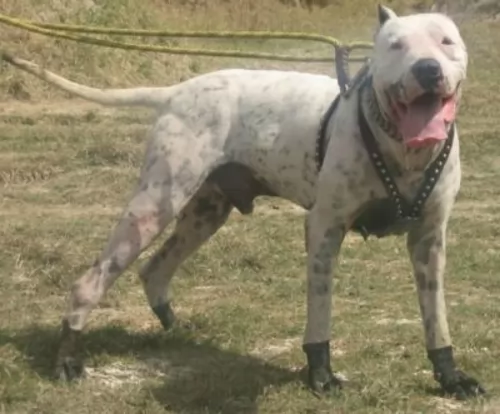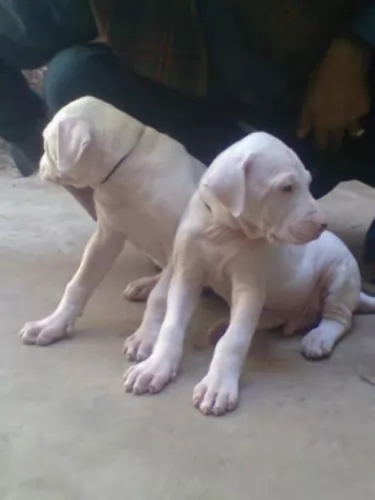 Petzlover
PetzloverGull Dong is originated from Pakistan but Russian Harlequin Hound is originated from Russia. Gull Dong may grow 38 cm / 15 inches higher than Russian Harlequin Hound. Gull Dong may weigh 32 kg / 71 pounds more than Russian Harlequin Hound. Both Gull Dong and Russian Harlequin Hound has same life span. Both Gull Dong and Russian Harlequin Hound has same litter size. Both Gull Dong and Russian Harlequin Hound requires Low Maintenance.
 The Gull Dong dog is thought to come from British Colonial India during the 1900's. The area later became known as Pakistan, and this is where the dog originated from.
The Gull Dong dog is thought to come from British Colonial India during the 1900's. The area later became known as Pakistan, and this is where the dog originated from.
Known also as the Bully Gull Terr, the dog came about by crossing Bully Kutta (Pakistani Mastiff) with a pure bred Gull Terr. The breeders wanted a dog that had the best features and characteristics of both the 2 dog breeds.
They were looking for particular characteristics such as size, strength and speed. This is a rare dog breed and he isn’t associated with any kennels or clubs, so not many records have been kept regarding their origin and development.
The origins of the Russian Harlequin Hound are somewhat vague as there are many Russian hunting hounds and many of them have a similar ancestry.
The Russian Harlequin Hound is an indigenous hound whose origins go back to the 18th century. The first breed standard was published in 1925.
The breed was then developed during the early 1900s – being a mix of Russian Hound and English Foxhound. The Russian Harlequin Hound is a rare dog breed and you will find it almost exclusively in Russia.
 The deep chested Gull Dong is a large dog and stands at 76 – 106cm in height and weighs in the region of 40 – 63kg.
The deep chested Gull Dong is a large dog and stands at 76 – 106cm in height and weighs in the region of 40 – 63kg.
He has a short, smooth coat in various colors such as white, grey, black, brindle or bi-color such as white with black spots. He is a muscular, powerful breed dog and his ears are mostly cropped, but when left they are short and floppy. His tail can be docked but these days it tends to be left long. He has a huge head, and similar to bulldogs, this mastiff dog has loose skin around the jaw and neck.
This is a strong-willed dog who is also intelligent. Just his sheer size will require that you have him trained and socialized. It is actually important to train and discipline this dog as he is strong willed. He is intelligent and learns easily.
After training, he will require a strong, firm and consistent owner. He is fairly suspicious of strangers and won't take kindly to anyone who tries to come onto his properly. He is a dominant, aggressive dog and while he is a loyal, loving pet with his human family, he isn't an ideal dog to have with small children in the home.
The Russian Harlequin Hound is a medium to large sized dog that stands between 55 – 68cm in height and weighs between 18 – 31kg.
He has a solid build with long, straight legs with a long tail that can be slightly curved. The head is broad and square with medium sized ears which are floppy. The short coat is essentially white with tri-colored markings of white, tan and black.
The Russian Harlequin Hound has an amicable expression to his face and is a friendly social dog breed. He is lively and energetic, and with his hunting background will required a good deal of exercise.
They make great family pets, getting on well with children in the home and making friends with any other pets in the family. He is a gentle dog and with training and socialization is well mannered and obedient.
He loves his human family and wants to spend time with them in their company. He isn't suited to life in the city and a small property, but will require a home with bigger grounds.
 This is a powerful, intelligent dog and with training and socialization he is capable of becoming a loving, protective pet who listens to you.
This is a powerful, intelligent dog and with training and socialization he is capable of becoming a loving, protective pet who listens to you.
He does tend to be aggressive and therefore people who are buying a dog for the first time might battle with the characteristics of this dog. He will certainly need a firm, strong, patient owner. He isn't the wisest choice for when you've got small children in the house, though well trained dogs and children are able to get along well together.
When your heavy, muscular Gull Dong is handled in a firm, kind manner, he is well exercised and fed and treated firmly and kindly, he is able to make a great, loyal companion.
The Russian Harlequin Hound has always been a hunting dog, known for his excellent hunting skills. He isn’t only a good hunting dog, but he makes a good family pet too.
If you’re looking for an unusual dog breed that is also intelligent, loyal and loving, then you might want to consider this Russian Harlequin Hound.
 The Gull is a fairly healthy dog, and with good care he can reach 10, 11 or 12 years of age.
The Gull is a fairly healthy dog, and with good care he can reach 10, 11 or 12 years of age.
If you choose to own a white one, you will know that he is susceptible to deafness and skin problems. White coated dogs battle with deafness, and the reason for this is that they carry the piebald gene. The piebald gene is a result of the absence of melanocytes – those cells which create pigment.
The ability to hear comes from a layer of cells within the inner ear which come from the same stem cell source. Without this stem cell, the dog isn't able to make this specialized layer of hearing cells.
With hip dysplasia, the head of the thigh bone doesn’t fit properly into the hip socket, resulting in the bone wearing away and arthritis settling in. Your dog can experience pain and stiffness and he can become lame. You'll notice he is no longer enthusiastic to join in with games and exercise.
Hip dysplasia can be managed with medication while some dog owners, if they can afford it, turn to surgery which can be very costly.
He is a deep chested dog and this means you need to be aware of the risks associated with bloat, an emergency gastrointestinal syndrome which can be life threatening and where your dogs stomach becomes hard and bloated.
Your Russian Harlequin Hound is a rare dog breed that can reach 12 years of age if well cared for. There are some dog ailments that must be watched for. Cancer, ear infections and skin allergies can be problems to look out for. Other troublesome ailments can be -
This is a more common disease with deep-chested dogs, and the deep chested Russian Harlequin Hound is prone to bloat. Gas is trapped in the stomach and the stomach can actually twist. It can be life threatening. Your pet will have a hard, swollen belly and will be restless and salivating. Get him to the vet immediately. He may well require immediate surgery.
This condition is all about problems with the hip joints. It is sad for any dog with this disease as it can be painful for your pet to walk. Inflammation and arthritis can mean your pet being in pain. He can become lame too.
There are anti-inflammatory medications and your vet will suggest other treatments to make sure your pet is as comfortable as can be.
 Plenty of room to run around in is important for the Gull Dong as he is a working breed who is used to having a job to do. You will certainly need to take him on walks or play rope- and ball games with him.
Plenty of room to run around in is important for the Gull Dong as he is a working breed who is used to having a job to do. You will certainly need to take him on walks or play rope- and ball games with him.
The Gull will require brushing twice a week as he is a short haired dog and an average shedder.
This is a large energetic dog and you will need to feed him a high quality food specially for large, energetic dogs. He needs his full quota of minerals and vitamins in his food. Provide him with homemade food such as cooked chicken, rice and vegetables and some raw meat from time to time. Never leave him without a constant supply of fresh, cool drinking water.
The Russian Harlequin Hound needs both mental and physical stimulation. He is a curious dog and wants to be out and about sniffing around and exploring. He will need to have a walk every day as well as lots of ball- and rope games. He will suit being the pet of a busy, outdoorsy family as opposed to a family of couch potatoes.
The Russian Harlequin Hound is looked upon as a low maintenance dog breed, and with his short, dense coat you can get by with just brushing him twice a week. Because he is such a lover of the outdoors check him over for ticks and fleas when you brush him.
Check inside his ears for redness and infection.
Open his mouth and look for bad, rotting teeth.
Check him over for any unusual lumps.
Make sure his eyes are clear and free of discharge.
Trim his nails.
Every dog should be fed excellent food as this encourages good health. Commercially manufactured dog foods can be wonderfully convenient and nutritious if you get the better quality ones.
Try and include some simple, tasty home-made food to his diet . High-quality dry dog food will provide a balanced diet, but you want to make it a little more tasty for him by giving him some chopped up boiled chicken, brown rice, sweet potatoes, carrots and spinach. This can be added into the dry kibble twice a week.
Try and include some raw meat occasionally. Fresh, cool water should always be available around the clock.